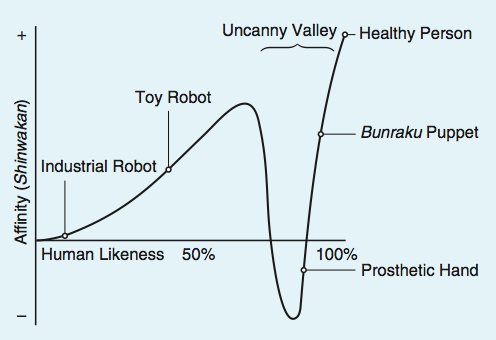The Uncanny Valley by Masahiro Mori is a highly referenced 1970 paper about human reaction to realistic robots. The first authorized and reviewed English translation has been published in the IEEE Spectrum, and is available online. He starts the paper by explaining, “in climbing toward the goal of making robots appear human, our affinity for them increases until we come to a valley, which I call the uncanny valley.”
Here’s an excerpt:
Since creating an artificial human is itself one of the objectives of robotics, various efforts are underway to build humanlike robots. For example, a robot’s arm may be composed of a metal cylinder with many bolts, but by covering it with skin and adding a bit of fleshy plumpness, we can achieve a more humanlike appearance. As a result, we naturally respond to it with a heightened sense of affinity.
Many of our readers have experience interacting with persons with physical disabilities, and all must have felt sympathy for those missing a hand or leg and wearing a prosthetic limb. Recently, owing to great advances in fabrication technology, we cannot distinguish at a glance a prosthetic hand from a real one. Some models simulate wrinkles, veins, fingernails, and even fingerprints. Though similar to a real hand, the prosthetic hand’s color is pinker, as if it had just come out of the bath.
One might say that the prosthetic hand has achieved a degree of resemblance to the human form, perhaps on a par with false teeth. However, when we realize the hand, which at first site looked real, is in fact artificial, we experience an eerie sensation. For example, we could be startled during a handshake by its limp boneless grip together with its texture and coldness. When this happens, we lose our sense of affinity, and the hand becomes uncanny.
Here’s the diagram, as published on IEEE Spectrum:







